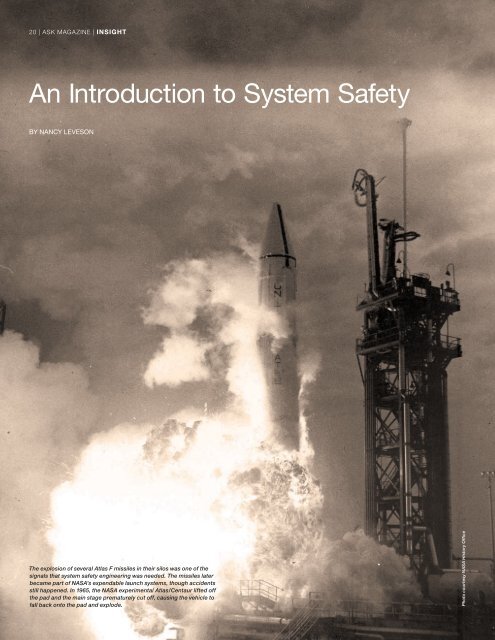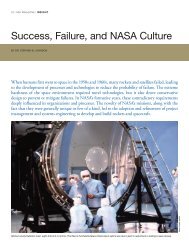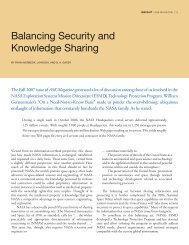An Introduction to System Safety - NASA ASK Magazine
An Introduction to System Safety - NASA ASK Magazine
An Introduction to System Safety - NASA ASK Magazine
Create successful ePaper yourself
Turn your PDF publications into a flip-book with our unique Google optimized e-Paper software.
20 | <strong>ASK</strong> MAGAZINE | INSIGHT<br />
<strong>An</strong> <strong>Introduction</strong> <strong>to</strong> <strong>System</strong> <strong>Safety</strong><br />
By NANCy LEvESON<br />
The explosion of several Atlas F missiles in their silos was one of the<br />
signals that system safety engineering was needed. The missiles later<br />
became part of <strong>NASA</strong>’s expendable launch systems, though accidents<br />
still happened. In 1965, the <strong>NASA</strong> experimental Atlas/Centaur lifted off<br />
the pad and the main stage prematurely cut off, causing the vehicle <strong>to</strong><br />
fall back on<strong>to</strong> the pad and explode.<br />
Pho<strong>to</strong> courtesy <strong>NASA</strong> His<strong>to</strong>ry Office
<strong>ASK</strong> MAGAZINE | 21<br />
<strong>System</strong> safety uses systems theory and systems engineering approaches <strong>to</strong> prevent foreseeable accidents<br />
and minimize the effects of unforeseen ones. It considers losses in general, not just human death or injury.<br />
Such losses may include destruction of property, loss of mission, and environmental harm.<br />
A Little His<strong>to</strong>ry<br />
Rigorous, defined approaches <strong>to</strong> safety engineering mostly arose<br />
after World War II, when the A<strong>to</strong>mic Energy Commission (and<br />
later the Nuclear Regula<strong>to</strong>ry Commission) were engaged in a<br />
public debate about the safety of nuclear power; civil aviation was<br />
trying <strong>to</strong> convince a skeptical public <strong>to</strong> fly; the chemical industry<br />
was coping with larger plants, increasingly lethal chemicals, and<br />
heightened societal concern about pollution; and the Department<br />
of Defense (DoD) was developing ballistic missile systems and<br />
increasingly dangerous weapons. These parallel efforts resulted in<br />
very different approaches, mostly because the problems they needed<br />
<strong>to</strong> solve were different.<br />
While the nuclear power, commercial aircraft, chemical, and<br />
other industries have taken a conservative approach <strong>to</strong> introducing<br />
new technology, changing designs slowly over time, defense and<br />
space systems have pushed the technology envelope, developing<br />
tremendously complex, novel designs that stretched the limits<br />
of current engineering knowledge, continually introducing<br />
new and unproven technology, with limited opportunities <strong>to</strong><br />
test and learn from extensive experience. In response, a unique<br />
approach <strong>to</strong> engineering for safety, called system safety, arose in<br />
these industries.<br />
When the Atlas and Titan intercontinental ballistic missiles<br />
(ICBMs) were being developed in the 1950s, system safety was not<br />
yet identified and assigned as a specific responsibility. Instead, each<br />
designer, manager, and engineer was responsible for the reliability of<br />
his particular component or subsystem. As a result, many interface<br />
problems went unnoticed until it was <strong>to</strong>o late. Within eighteen<br />
months after the fleet of 71 Atlas F missiles became operational, four<br />
blew up in their silos during operational testing. The missiles also<br />
had an extremely low launch success rate. The air force had typically<br />
blamed most accidents on pilot error, but these new liquid-propellant<br />
missiles had no pilots <strong>to</strong> blame and yet blew up frequently and with<br />
devastating results. When these early losses were investigated, a large<br />
percentage of them were traced <strong>to</strong> deficiencies in design, operations,<br />
and management. The importance of treating safety as a system<br />
problem became clear and, as a result, systems engineering and system<br />
safety (a subdiscipline of systems engineering) were developed.<br />
The Minuteman ICBM became the first weapon system <strong>to</strong> have<br />
a contractual, formal, disciplined system safety program. At first, few<br />
techniques that could be used on these systems existed, but specialized<br />
system safety practices evolved over time. Particular emphasis was<br />
placed on hazard analysis techniques, such as fault trees, which were<br />
first developed <strong>to</strong> cope with complex programs like Minuteman.<br />
While these techniques were useful for the technology of the time, new<br />
technologies, particularly digital technology and software, have made<br />
many of them no longer appropriate for the increasingly complex,<br />
software-intensive systems we build <strong>to</strong>day. Unfortunately, recognition<br />
of these limitations has been slow. Attempts <strong>to</strong> apply techniques<br />
developed for the simpler and primarily electro-mechanical systems of<br />
the past continue, with only partial success.<br />
The space program was the second major area <strong>to</strong> apply system<br />
safety approaches in a disciplined way. After the 1967 Apollo 1<br />
fire that killed three astronauts, <strong>NASA</strong> commissioned the General<br />
Electric Company at Day<strong>to</strong>na Beach, among others, <strong>to</strong> develop<br />
policies and procedures that became models for civilian space flight<br />
safety activities. Jerome Lederer was hired <strong>to</strong> head safety at <strong>NASA</strong>.<br />
Under his leadership, an extensive system safety program was set<br />
up for space projects, much of it patterned after the air force and<br />
DoD programs. Many of the same engineers and companies that<br />
had established formal system safety defense programs also were<br />
involved in space programs, and the systems engineering and system<br />
safety technology and management activities were transferred <strong>to</strong><br />
this new work.<br />
But as time has passed without major new manned space<br />
flight development projects at <strong>NASA</strong>, many of the very effective<br />
<strong>NASA</strong> system safety practices have been replaced by reliability<br />
engineering and approaches <strong>to</strong> safety used by industries with<br />
very different requirements. For Constellation <strong>to</strong> be successful,<br />
traditional system safety practices will need <strong>to</strong> be reemphasized and<br />
extended <strong>to</strong> handle new technology, particularly extensive use of<br />
software and computers.
22 | <strong>ASK</strong> MAGAZINE<br />
What Is <strong>System</strong> <strong>Safety</strong>?<br />
The primary concern of system safety is the management<br />
of system hazards as opposed <strong>to</strong> emphasis on eliminating<br />
component failures in reliability engineering. Borrowing<br />
Thomas Huxley’s definition of science, in 1968 George Mueller<br />
described the then-new discipline of system safety engineering<br />
as “organized common sense.” It is a planned, disciplined, and<br />
systematic approach <strong>to</strong> identifying, analyzing, eliminating,<br />
and controlling hazards by analysis, design, and management<br />
procedures throughout a system’s life cycle. <strong>System</strong> safety<br />
activities start in the earliest concept development stages of<br />
a project and continue through design, production, testing,<br />
operational use, and disposal.<br />
Although system safety is a relatively new and stillevolving<br />
discipline, some general principles hold for its various<br />
manifestations and distinguish it from other approaches <strong>to</strong><br />
safety and risk management.<br />
• <strong>System</strong> safety emphasizes building in safety, not adding<br />
protection features <strong>to</strong> a completed design. <strong>System</strong> safety<br />
emphasizes the early identification of hazards so action can<br />
be taken <strong>to</strong> eliminate or minimize them in early design<br />
decisions; 70 <strong>to</strong> 90 percent of the design decisions that<br />
affect safety are made in concept development, requirements<br />
definition, and architectural design. The degree <strong>to</strong> which<br />
it is economically feasible <strong>to</strong> eliminate or minimize a<br />
hazard rather than <strong>to</strong> control it depends on the stage in<br />
system development at which the hazard is identified and<br />
considered. Early integration of safety considerations in<strong>to</strong><br />
the development process allows maximum safety with<br />
minimum negative impact. The usually more expensive and<br />
less effective alternative is <strong>to</strong> design first, identify the hazards,<br />
and then add on protective equipment <strong>to</strong> control the hazards<br />
when they occur. A recent demonstration project for the Jet<br />
Propulsion Labora<strong>to</strong>ry showed how safety can be designed<br />
in<strong>to</strong> a spacecraft (an outer-planets explorer, in this case) from<br />
the early concept formation and trade study stages. New<br />
hazard analysis approaches that include software were used.<br />
(See http://sunnyday.mit.edu/papers/IEEE-Aerospace.pdf.)<br />
• <strong>System</strong> safety deals with systems as a whole rather<br />
than with subsystems or components. <strong>Safety</strong> is an<br />
emergent property of systems, not components. One<br />
of the principle responsibilities of system safety is <strong>to</strong><br />
evaluate the interfaces between the system components<br />
and determine the effects of component interaction. (The<br />
The Minuteman ICBM became<br />
the first weapon system <strong>to</strong> have a<br />
formal, disciplined system safety<br />
program. Here, a Minuteman II<br />
launches successfully.<br />
Pho<strong>to</strong> Credit: U.S. Air Force
<strong>ASK</strong> MAGAZINE | 23<br />
FOR CONSTELLATION TO bE SUCCESSFUL, TRADITIONAL SySTEM SAFETy PRACTICES<br />
wILL NEED TO bE REEMPHASIZED AND ExTENDED TO HANDLE NEw TECHNOLOGy,<br />
PARTICULARLy ExTENSIVE USE OF SOFTwARE AND COMPUTERS.<br />
set of components includes humans, machines, and the<br />
environment.) <strong>Safety</strong> is an emergent system property. It is<br />
not possible <strong>to</strong> determine whether a spacecraft design<br />
is acceptably safe, for example, by examining a single<br />
valve. In fact, statements about the “safety of the valve”<br />
without information about the context in which it is used<br />
are meaningless. Conclusions can be reached about the<br />
reliability of the valve (defined as the probability that<br />
the behavior of the valve will satisfy its specification over<br />
time and under given conditions), but safety can only be<br />
determined by the relationship between the valve and the<br />
other spacecraft components, in the context of the whole.<br />
• <strong>System</strong> safety takes a larger view of hazard causes than<br />
just failures. A lack of differentiation between safety and<br />
reliability is widespread at <strong>NASA</strong> and elsewhere. Hazards<br />
are not always caused by component failures, and all<br />
failures do not cause hazards. Reliability engineering<br />
concentrates on component failure as the cause of accidents<br />
and a variety of techniques (including redundancy<br />
and overdesign) are used <strong>to</strong> minimize them. As early<br />
missile systems showed, however, losses may arise from<br />
interactions among system components; serious accidents<br />
have occurred when the system components were all<br />
functioning exactly as specified. The Mars Polar Lander<br />
loss is an example. Each component worked as specified<br />
but problems arose in the interactions between the landing<br />
leg sensors and the software logic responsible for shutting<br />
down the descent engines. Reliability analysis considers<br />
only the possibility of accidents related <strong>to</strong> failures; it does<br />
not investigate potential damage that could result from<br />
successful operation of individual components. Software,<br />
ubiqui<strong>to</strong>us in space systems <strong>to</strong>day, is an important<br />
consideration here. In most software-related accidents,<br />
the software operates exactly as intended. Focusing on<br />
increasing the reliability with which the software satisfies<br />
its requirements will have little impact on system safety.<br />
Reliability and safety may even conflict. Sometimes, in<br />
fact, increasing safety can decrease system reliability. Under<br />
some conditions, for instance, shutting down a system may<br />
be an appropriate way <strong>to</strong> prevent a hazard. That increasing<br />
reliability can diminish safety may be a little harder <strong>to</strong> see.<br />
For example, increasing the reliability (reducing the failure<br />
rate) of a tank by increasing the burst pressure–<strong>to</strong>–working<br />
pressure ratio may result in worse losses if the tank does<br />
rupture at the higher pressure. <strong>System</strong> safety analyses start<br />
from hazards, not failures and failure rates, and include<br />
dysfunctional interactions among components and system<br />
design errors. The events leading <strong>to</strong> an accident may<br />
be a complex combination of equipment failure, faulty<br />
maintenance, instrumentation and control inadequacies,<br />
human actions, design errors, and poor management<br />
decision making. All these fac<strong>to</strong>rs must be considered.<br />
• <strong>System</strong> safety emphasizes analysis in addition <strong>to</strong> past<br />
experience and codes of practice. Standards and codes<br />
of practice incorporate experience and knowledge about<br />
how <strong>to</strong> reduce hazards, usually accumulated over long<br />
periods of time from previous mistakes. While the use of<br />
such standards and learning from experience is essential<br />
in all aspects of engineering, including safety, the pace of<br />
change <strong>to</strong>day does not always allow for such experience <strong>to</strong><br />
accumulate. <strong>System</strong> safety analysis attempts <strong>to</strong> anticipate<br />
and prevent accidents and near misses before they occur,<br />
in addition <strong>to</strong> learning from the past.<br />
• <strong>System</strong> safety emphasizes qualitative rather than<br />
quantitative approaches. A system safety approach<br />
identifies hazards as early as possible in the design stage and<br />
then designs <strong>to</strong> eliminate or control those hazards. At these<br />
early stages, quantitative information usually does not exist.<br />
Although such information would be useful in prioritizing
24 | <strong>ASK</strong> MAGAZINE<br />
Seated at the witness table before the Senate Committee on Aeronautical and Space Services hearing on the Apollo 1 accident are (left <strong>to</strong> right) Dr. Robert C.<br />
Seamans, <strong>NASA</strong> deputy administra<strong>to</strong>r; James E. Webb, <strong>NASA</strong> administra<strong>to</strong>r; Dr. George E. Mueller, associate administra<strong>to</strong>r for Manned Space Flight; and Maj. Gen.<br />
Samuel C. Phillips, Apollo Program direc<strong>to</strong>r. In an effort <strong>to</strong> prevent another such tragedy from occurring, <strong>NASA</strong> commissioned the General Electric Company<br />
and others <strong>to</strong> develop policies and procedures that became models for civilian space flight safety activities.<br />
hazards, subjective judgments about the likelihood of a<br />
hazard are usually adequate and all that is possible when<br />
design decisions must be made. In addition, probabilistic<br />
risk analyses that exclude potential causes of an accident,<br />
including interactions among non-failing components,<br />
design errors, software and hardware requirements errors, and<br />
poor management decision making, can lead <strong>to</strong> dangerous<br />
complacency and focusing engineering efforts only on the<br />
accident causes for which those measures are possible. If<br />
enough were known about fac<strong>to</strong>rs such as design errors <strong>to</strong><br />
define a probability for them, then safety would be more<br />
effectively enhanced by removing the design error than by<br />
measuring it in order <strong>to</strong> convince someone that it will never<br />
cause an accident. In the case of the Mars Polar Lander, if the<br />
scenario that unfolded had been known and could have been<br />
included in a probabilistic risk analysis, then the engineers<br />
would have had enough information <strong>to</strong> change the software<br />
so the unsafe control command would not be issued.<br />
• <strong>System</strong> safety is more than just systems engineering<br />
and must incorporate management and safety culture<br />
concerns. <strong>System</strong> safety engineering is an important<br />
part of system safety, but the concerns of system safety<br />
extend beyond the traditional boundaries of engineering.<br />
In 1968, Jerome Lederer, then the direc<strong>to</strong>r of the <strong>NASA</strong><br />
Manned Flight <strong>Safety</strong> Program for Apollo, wrote:<br />
<strong>System</strong> safety covers the <strong>to</strong>tal spectrum of risk<br />
management. It goes beyond the hardware and associated<br />
procedures of system safety engineering. It involves:<br />
attitudes and motivation of designers and production<br />
people, employee/management rapport, the relation<br />
of industrial associations among themselves and with<br />
government, human fac<strong>to</strong>rs in supervision and quality<br />
control, documentation on the interfaces of industrial<br />
and public safety with design and operations, the interest<br />
and attitudes of <strong>to</strong>p management, the effects of the<br />
legal system on accident investigations and exchange of<br />
information, the certification of critical workers, political<br />
considerations, resources, public sentiment, and many<br />
other nontechnical but vital influences on the attainment<br />
of an acceptable level of risk control. These nontechnical<br />
aspects of system safety cannot be ignored.<br />
Using these general principles, system safety attempts <strong>to</strong><br />
manage hazards through analysis, design, and management<br />
procedures. Key activities include analyzing system hazards from<br />
the <strong>to</strong>p down, starting in the early concept design stage <strong>to</strong> eliminate<br />
or control hazards and continuing during the life of the system <strong>to</strong><br />
evaluate changes in the system or the environment; documenting<br />
and tracking hazards and their resolutions (establishing audit trails);<br />
designing <strong>to</strong> eliminate or control hazards and minimize damage;<br />
maintaining safety information systems and documentation; and<br />
establishing reporting and information channels. ●<br />
For more information see the following:<br />
• http://sunnyday.mit.edu/papers/jsr.pdf<br />
• http://sunnyday.mit.edu/accidents/safetyscience-single.pdf<br />
• http://sunnyday.mit.edu/ESMD-Final-Report.pdf<br />
nancy Leveson is a professor of aeronautics and<br />
astronautics at Massachusetts Institute of Technology. She has<br />
been associated with <strong>NASA</strong> for more than twenty years, was a<br />
member of the <strong>NASA</strong> Aerospace <strong>Safety</strong> Advisory Panel at the<br />
time of the Columbia loss, and was a consultant for the Columbia<br />
Accident Investigation Board. She is a member of the National<br />
Academy of Engineering.<br />
Pho<strong>to</strong> Credit: <strong>NASA</strong>




